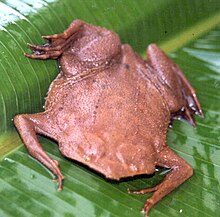Pipoidea
| Pipoidea Temporal range: Jurassic–recent,
| |
|---|---|

| |
| Pipa pipa, the common Suriname toad | |
| Scientific classification | |
| Kingdom: | Animalia |
| Phylum: | Chordata |
| Class: | Amphibia |
| Order: | Anura |
| Clade: | Pipoidea Laurent in Fuhn, 1960 |
| Subgroups[2] | |
Pipoidea are a clade of frogs that have variously been defined as a suborder (original definition),[3] superfamily,[1] or an unranked node-based taxon.[2] There is no single, authoritative higher-level classification of frogs, and Vitt and Caldwell (2014) use name Xenoanura for a similar clade, skipping Pipoidea altogether,[4] as did Frost et al. (2006).[5]
In 1993 Pipoidea was defined by Ford and Cannatella as the node-based taxon that contains the most recent common ancestor of living Pipidae and Rhinophrynidae as well as all its descendants:[2]
| Pipoidea |
| ||||||||||||||||||
"Pipids" are a group of fossil taxa with uncertain relationships: Thoraciliacus, Nevobatrachus, Saltenia, and Eoxenopoides.[2] Cannatella (2008) added Shomronella to this group.[6]
The synapomorphies that define Pipoidea are the absence of mentomeckelian bones, absence of lateral alae of the parasphenoid, fusion of the into an azygous element, greatly enlarged otic capsules, and a tadpole with paired spiracles and which lacks beaks and denticles.[2][6] Later genetic work has supported Pipoidea as a monophyletic group.[5]
References[]
- ^ a b "Superfamily Pipoidea Fitzinger 1843". Paleobiology Database. Fossilworks. Retrieved 17 December 2021.
- ^ a b c d e Ford, Linda S. & Cannatella, David C. (1993). "The major clades of frogs". Herpetological Monographs. 7: 94–117. doi:10.2307/1466954. JSTOR 1466954.
- ^ Frost, Darrel R. (2020). "Anura". Amphibian Species of the World: an Online Reference. Version 6.1. American Museum of Natural History. doi:10.5531/db.vz.0001. Retrieved 15 May 2020.
- ^ Vitt, Laurie J. & Caldwell, Janalee P. (2014). Herpetology: An Introductory Biology of Amphibians and Reptiles (4th ed.). Academic Press. pp. 92–95.
- ^ a b Frost, D. R.; Grant, T.; Faivovich, J. N.; Bain, R. H.; Haas, A.; Haddad, C. L. F. B.; De Sá, R. O.; Channing, A.; Wilkinson, M.; Donnellan, S. C.; Raxworthy, C. J.; Campbell, J. A.; Blotto, B. L.; Moler, P.; Drewes, R. C.; Nussbaum, R. A.; Lynch, J. D.; Green, D. M. & Wheeler, W. C. (2006). "The amphibian tree of life". Bulletin of the American Museum of Natural History. 297: 1–291. doi:10.1206/0003-0090(2006)297[0001:TATOL]2.0.CO;2. hdl:2246/5781.
- ^ a b Cannatella, David (11 January 2008). "Anura: Discussion of Phylogenetic Relationships (Pipimorpha)". Tree of Life Project. Retrieved 25 April 2016.
- Frogs by classification
- Taxa named by Raymond Laurent